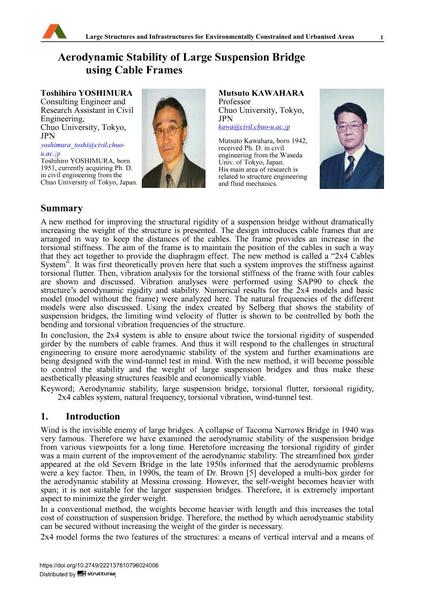Aerodynamic Stability of Large Suspension Bridge using Cable Frames

|
|
|||||||||||
Bibliographic Details
| Author(s): |
Toshihiro Yoshimura
Mutsuto Kawahara |
||||
|---|---|---|---|---|---|
| Medium: | conference paper | ||||
| Language(s): | English | ||||
| Conference: | IABSE Symposium: Large Structures and Infrastructures for Environmentally Constrained and Urbanised Areas, Venice, Italy, 22-24 September 2010 | ||||
| Published in: | IABSE Symposium Venice 2010 | ||||
|
|||||
| Page(s): | 148-149 | ||||
| Total no. of pages: | 8 | ||||
| Year: | 2010 | ||||
| DOI: | 10.2749/222137810796024006 | ||||
| Abstract: |
A new method for improving the structural rigidity of a suspension bridge without dramatically increasing the weight of the structure is presented. The design introduces cable frames that are arranged in way to keep the distances of the cables. The frame provides an increase in the torsional stiffness. The aim of the frame is to maintain the position of the cables in such a way that they act together to provide the diaphragm effect. The new method is called a “2x4 Cables System”. It was first theoretically proven here that such a system improves the stiffness against torsional flutter. Then, vibration analysis for the torsional stiffness of the frame with four cables are shown and discussed. Vibration analyses were performed using SAP90 to check the structure’s aerodynamic rigidity and stability. Numerical results for the 2x4 models and basic model (model without the frame) were analyzed here. The natural frequencies of the different models were also discussed. Using the index created by Selberg that shows the stability of suspension bridges, the limiting wind velocity of flutter is shown to be controlled by both the bending and torsional vibration frequencies of the structure. In conclusion, the 2x4 system is able to ensure about twice the torsional rigidity of suspended girder by the numbers of cable frames. And thus it will respond to the challenges in structural engineering to ensure more aerodynamic stability of the system and further examinations are being designed with the wind-tunnel test in mind. With the new method, it will become possible to control the stability and the weight of large suspension bridges and thus make these aesthetically pleasing structures feasible and economically viable. |
||||
| Keywords: |
wind tunnel test natural frequency aerodynamic stability large suspension bridge torsional flutter torsional rigidity 2x4 cable system torsional vibration
|
||||

